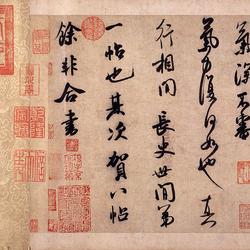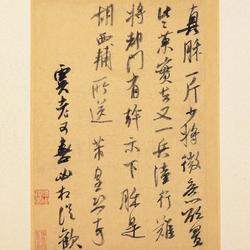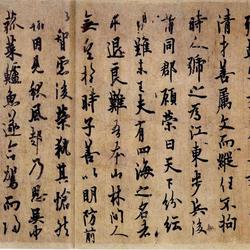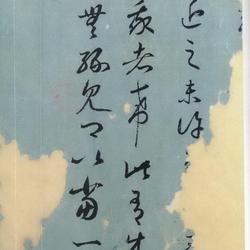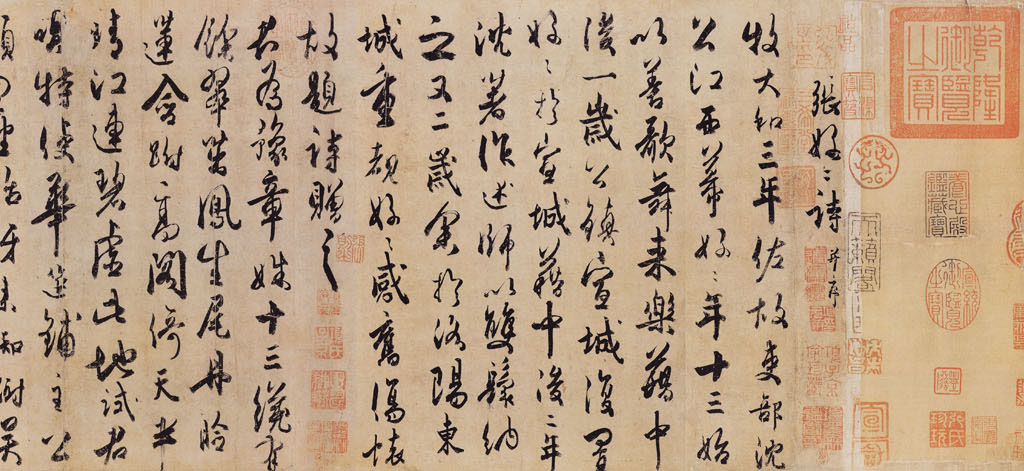
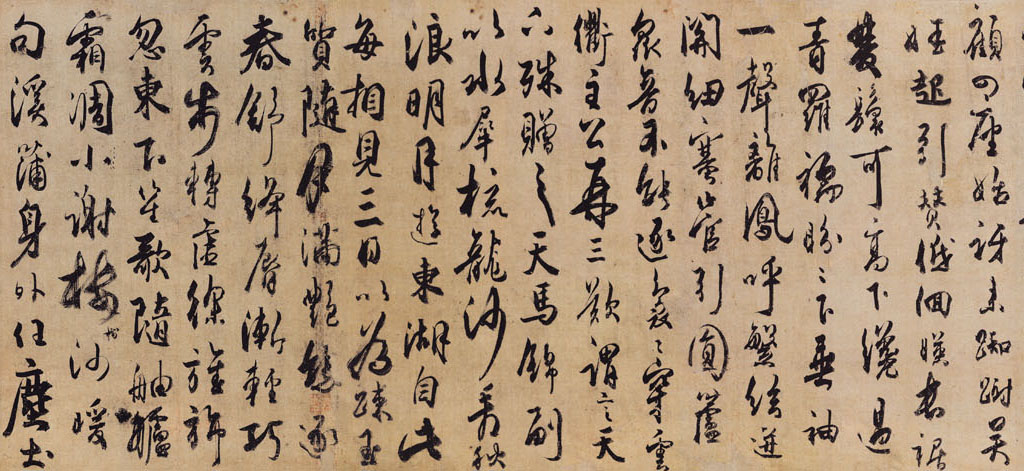
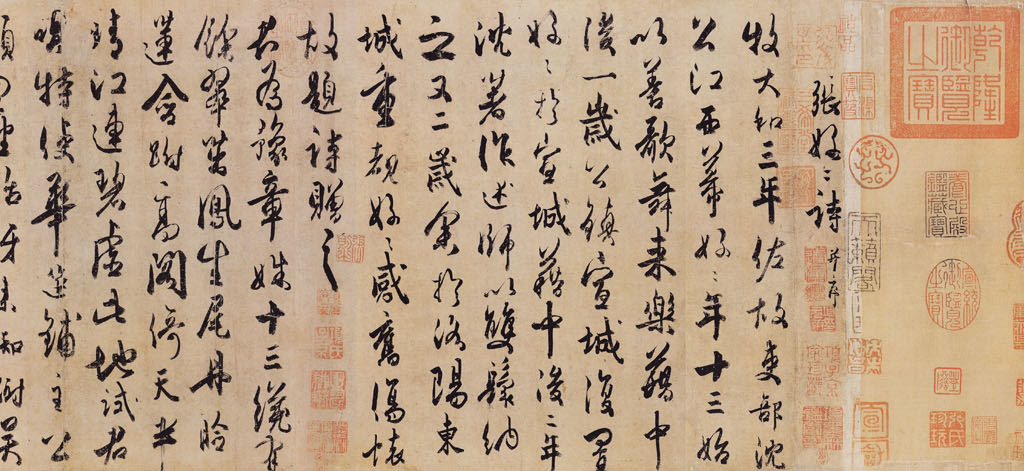
A native of Jingzhao Wannian in the Tang Dynasty (today's Xi'an, Shaanxi Province). His courtesy name was Muzhi, he was a member of the Jinshi Ranking, and he was once a member of the imperial court, Wailang, and later moved to the official position of Shushe. ICBC cursive script. A famous poet in the Tang Dynasty, there are twenty volumes of "Fan Chuan Collection" handed down to the world. Because Du Fu preceded him, later generations called him Xiao Du.
"Zhang Haohao's Poems" was written and written in the ninth year of Du Mu's reign. The writing style is running script. This is the only piece of Du Mu's ink that has been handed down from generation to generation. The handwriting of his calligraphy is charming and vigorous, and the turning points are like Sun Guoting's "Shupu". There have been many comments from past dynasties. Bao Shichen of the Qing Dynasty praised: The technique of using the brush can be seen at both ends of the painting, while the ancients' rich and unbridled style, which is unattainable, can be seen in the middle of the painting. There are still signs to be found because of the manipulation of the two ends of the cover; the reason why the cut is abundant but not timid, solid but not empty, is not due to the insight of the bone potential, which cannot be caused by luck. The beauty of Zhongshi is hard to describe after martial virtue. Ancient and modern calligraphy techniques have not reached this point, but Sibai has a saying that the strokes must be straight and not easily softened. Although this is not true, the knowledge is different. The postscript to Du Mu's "Zhang Haohao Shi" says that it "has the charm of the Six Dynasties", and Gai also appreciated the richness of it. ("Yizhou Shuangji") It is also said: If the flowers are very bright, the essence will be exhausted internally, and the color will fade externally; if the vegetation is deep in autumn, the leaves will be withered and the branches will be sparse, the business will be condensed internally, and the vitality will be exhausted externally. The reason for the romance of the book is that due to the weak power, the pen cannot capture the ink, and the fingers cannot foreshadow and write it out at will. Therefore, the disadvantages of the romance are especially serious at the end of the page. Excerpts from "Lanting Poetry" and "Zhang Haohao Poetry" in Xihongtang, the knotting method is simple and easy, the style is scattered, and those who are not brilliant are full of energy. The fullness of Qi is due to the inner strength, and the middle strength is due to the strength of the fingers. This achievement is very difficult to achieve, but it must be understood. ("Art Boat Shuangji")
"Zhang Haohao's Poems" volume, Tang Dynasty, Du Mu's book, paper, running script. Length 28.2cm, width 16.2cm. Collection of the Palace Museum, Beijing
Explanation:
Zhang Haohao's poems with preface
In the third year of Mu Taihe's reign, he assisted the old official department Shen Gong in Jiangxi. On the thirteenth day of the good year, I begin to enjoy myself with good songs. One year later, he moved to the town of Xuancheng, where he was restored to his official residence in Xuancheng. When he was two years old, he became the narrator of Shen's writings and accepted him with his two servant girls. When I was two years old, I met Hao Hao again in the east city of Luoyang, and felt sad about the past, so I wrote a poem for him.
You are Yu Zhangshu, who is more than thirteen years old. The Cuizhuo phoenix has its tail, and the red lotus has its tarsus. The high pavilion leans half towards the sky, and the Zhangjiang couplet is blue and empty. This place is a test for you to sing, and the special envoy is Hua Yanpu. The Lord looked at the four seats and was surprised and hesitated. Wu Wa raised her head to praise her, and she hung low to reflect her long skirt. The two servant girls can be high and low, and they have only passed Qingluo Ru. Panpan drooped her sleeves and let out a cry of a young phoenix. The complicated strings burst out of the key points, and the cork tubes cracked the round reeds. All the sounds cannot be chased away, they curl through the clouds. The Lord sighed again and again, saying that the world is different. A gift of Tianma brocade, accompanied by a water rhinoceros comb. Watch the autumn waves in Longsha, and swim in the East Lake under the bright moon. Since then, every time we see each other, we have been apart for three days. The quality of jade becomes fuller with the moon, and its beauty becomes more beautiful with the spring. The crimson lips become lighter and lighter, and the cloud steps turn slowly. The jingzhao suddenly went down east, and the music and songs followed the boat. The frost has withered the trees, and the sand is warm and the trees in the stream are warm. There is dust outside the body, but there is great joy in front of the bottle. Piaoran gathers fairy guests, satirizes Fu and deceives each other. [The author was appointed as the school manager of Jixian. ] He was hired to wear a Baguio pendant and carried it in a Ziyun chariot. The sound of the water is far away when the cave is closed, and the shadow of the toad is lonely when the moon is high. Not long after you came, all Gaoyang disciples were scattered. We met again in Luocheng, and Wuwei became Danglong. Why do you blame me for suffering, a young man with gray beard? Is your friend here today? How can it be better to have nothing? After weeping in the gate hall, the water clouds and autumn scenery begin. The declining willows hang in the setting sun, and the cool breeze blows in the corner.
[Appendix] The following information comes from the website of the Palace Museum
Zhang Haohao's poem volume
"Zhang Haohao's Poems" volume, Tang Dynasty, Du Mu's book, paper, running script. Length 28.2cm, width 16.2cm.
It is the only remaining ink by a poet and calligrapher of the Tang Dynasty, and is also one of the rare calligraphy works of celebrities in the Tang Dynasty. Zhang Haohao is a singing girl with a beautiful appearance and outstanding talent. Du Mu's five-character poem was written for her and expressed his infinite sympathy for her misfortune. In the poem "Fan Chuan Collection" by Du Mu, the last two sentences of the ink mark are missing the words "Sa Jinman" and "Yishu" due to injury, but this does not damage the overall spirit of the calligraphy poem.
The scroll is made of linen paper and is very finely crafted. The book is written with a hard pen, strong and vigorous writing style, and many pen strokes. These are the characteristics of the paper and brushwork used in Tang Dynasty calligraphy. "Xuanhe Calligraphy" commented on Du Mu's calligraphy: "The style is vigorous and vigorous, matching the exterior and interior of the article", which means that the author's poetry and calligraphy have a unified style. On the front of the volume, there is a bookmark written by Zhao Ji of Emperor Huizong of the Song Dynasty, "Poems of Du Mu Zhang of Tang Dynasty" and various seals of Emperor Huizong of the Song Dynasty, which preserves the decoration style of the inner palace at that time. It was later passed to the collection of Jia Sidao of the Song Dynasty, Xiang Yuanbian of the Ming Dynasty, Zhang Xiaosi of the Ming Dynasty, Qing Biao of the Qing Dynasty Liang Dynasty and others, and entered the inner palace of Tibet during the Qianlong period. According to the "Shigutang Calligraphy and Painting Record Examination Volume 7", the postscripts of the Yuan Dynasty in this volume were transferred from the "Thousand Character Essay" by Zhao Mo of the Tang Dynasty. It is recorded in books such as "Xuanhe Calligraphy Collection", "Special Records of Calligraphy and Paintings Collection by Yuesheng", "Spectacular Life", "Daguan Records", "Records of Calligraphy and Paintings Seen by Wu Yue", "Shiqu Baoji·First Edition" and other books.
This volume was taken out of the palace by Emperor Puyi of the Qing Dynasty, and was later owned by Zhang Boju after it was scattered among the people. In 1956, Mr. Zhang Boju donated it to the government, and this precious cultural relic was collected by the Palace Museum.

